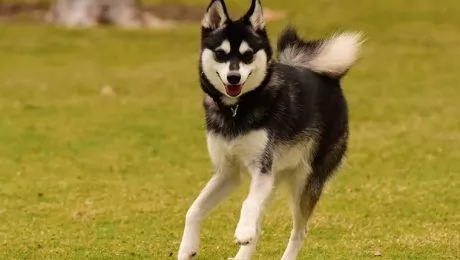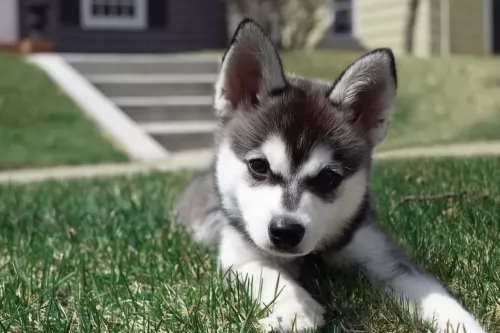 Petzlover
PetzloverAlaskan Klee Kai is originated from United States but Dogo Cubano is originated from Cuba. Alaskan Klee Kai may grow 11 cm / 4 inches shorter than Dogo Cubano. Alaskan Klee Kai may weigh 31 kg / 68 pounds lesser than Dogo Cubano. Alaskan Klee Kai may live 6 years more than Dogo Cubano. Both Alaskan Klee Kai and Dogo Cubano has same litter size. Both Alaskan Klee Kai and Dogo Cubano requires Low Maintenance.
 Alaskan Klee Kai breed is created in Alaska by Linda S Spurlin with help of her family. When she saw a smaller type of Siberian Husky, she immediately wanted to create a smaller type of Husky that will be a great companion dog. She did not create this breed with dogs that suffer from dwarfism as if it’s the case with most other breeders. She breeds Alaskan Husky with smaller dog breeds that looked a like a husky. Breeds like Alaskan Eskimo Dog or Schipperke. They are still not recognized by some Kennel clubs, but their popularity is constantly on the rise.
Alaskan Klee Kai breed is created in Alaska by Linda S Spurlin with help of her family. When she saw a smaller type of Siberian Husky, she immediately wanted to create a smaller type of Husky that will be a great companion dog. She did not create this breed with dogs that suffer from dwarfism as if it’s the case with most other breeders. She breeds Alaskan Husky with smaller dog breeds that looked a like a husky. Breeds like Alaskan Eskimo Dog or Schipperke. They are still not recognized by some Kennel clubs, but their popularity is constantly on the rise.
The Cuban Mastiff which came from Cuba, was developed from breeds of Mastiffs, Bulldogs and cattle dogs, with the breed being thought to be extinct since the end of the 19th century.
The Dogo Cubano had a number of roles to fulfill in its day and they were used for guarding stock, for dog fighting and for chasing runaway slaves. After the abolishment of slavery, the large dog had no real role and it died out.
Known also as the Cuban Mastiff or Mastin de Cuba, there isn’t much accuracy as to its origins, with the most common story for their origin being that they are descendants of the Molossus.
The dogs were later introduced into Western Europe, becoming fairly common in England and Spain. The dog was also was also mentioned in the works of canine authors Stonehenge and George Wood.
 Weight of the Alaskan Klee Klei variates from dog to dog, but average male size is between 33-44cm. While females size is 28-40cm. The weight of the average male, an adult dog is 13 to 15kg. As you may see Klee Klei can be very small dogs, and that depends on every dog.
Weight of the Alaskan Klee Klei variates from dog to dog, but average male size is between 33-44cm. While females size is 28-40cm. The weight of the average male, an adult dog is 13 to 15kg. As you may see Klee Klei can be very small dogs, and that depends on every dog.
A lifespan of Klee Klei is 12-16 years.
Litter Size of the breed again depends on every dog but normal size for this breed is between 4-8 puppies.
Other Name for Alaskan Klee Klei is just a Klee Klei.
The Dogo Cubano was generally similar to other Mastiffs and stood at rough 48 – 55cm in height and weighing in the region of 45kg.
He was a large dog, powerfully built, muscular and strong. Images of the dog show that it had strong, straight legs with a long tapering tail and medium-sized floppy ears that were sometimes cropped upwards and close to the head.
The dog breed came in a variety of colors such as brown, tan, fawn and brindle. The muzzle was broad and short and black. The dog had pronounced jowls with its face being fairly wrinkly.
This large dog was known for being a courageous, independent and aggressive dog. He became attached to his owner, showing protective characteristics .In those days the dog would have received simple training and certainly if such a large dog still existed today, it would have to receive training and socialization as well.
The Dogo Cubano was an intelligent dog and easily trainable, requiring an owner with a firm hand. Being an aggressive breed, the dog possibly wouldn’t have been the best companion for children. He also wouldn’t have got on too well with pets in the home as he was trained to be a fighter in his day. Independent and strong-willed, the dog would not have suited a novice dog owner.
 Klee Klei is very intelligent breed with a lot of energy. They love spending time with the family, especially in the outdoor activities. Klee Klei is very friendly towards children and new people, but they will also be excellent watchdogs too. Due to their intelligence, they are very easy to train. You should practice a positive way of awarding for them. They love pleasing and they love food, so it is a match made in heaven for training the Klee Klei. They will enjoy playing with other animals because they love to run and spend time with them, but you must socialize them from the early age. It is very important to socialize them with other animals and you will not have anything to worry about. They have a high prey drive so you will have to keep them on the leash while walking because if they notice something they will run towards it immediately. So for your, and your pet's safety, it is the best to keep the leash on. They do not bark a lot, but they will express when they are not pleasured because they can be very sensitive
Klee Klei is very intelligent breed with a lot of energy. They love spending time with the family, especially in the outdoor activities. Klee Klei is very friendly towards children and new people, but they will also be excellent watchdogs too. Due to their intelligence, they are very easy to train. You should practice a positive way of awarding for them. They love pleasing and they love food, so it is a match made in heaven for training the Klee Klei. They will enjoy playing with other animals because they love to run and spend time with them, but you must socialize them from the early age. It is very important to socialize them with other animals and you will not have anything to worry about. They have a high prey drive so you will have to keep them on the leash while walking because if they notice something they will run towards it immediately. So for your, and your pet's safety, it is the best to keep the leash on. They do not bark a lot, but they will express when they are not pleasured because they can be very sensitive
The Dogo Cubano was bred to be a guard dog as well as for dog fighting, but this large dog, with training and socialization, no doubt became a loyal and devoted family pet.
It was actually a social dog, being aggressive towards other dogs. He would be described as a dog better suited to a home with older children.
He was protective with his human family but not very active, being too big to be leaping around like other dog breeds. It is a pity that this large dog has disappeared as he had some good qualities.
 As most of the small breed dogs that are mixed with various breeds, this is one of the healthiest breeds. They do not have a lot of health issues, and usually, they tend to live a lot. Of course, you must be careful where are you buying your dog, and it is very important to choose the right owners that are taking care of the dogs and puppies. Some of the issues that this breed might have are luxation patella, thyroid disease, heart conditions, liver shunts, factor VII deficiency, and cataracts.
As most of the small breed dogs that are mixed with various breeds, this is one of the healthiest breeds. They do not have a lot of health issues, and usually, they tend to live a lot. Of course, you must be careful where are you buying your dog, and it is very important to choose the right owners that are taking care of the dogs and puppies. Some of the issues that this breed might have are luxation patella, thyroid disease, heart conditions, liver shunts, factor VII deficiency, and cataracts.
The Dogo Cubano was a generally healthy breed, but just like with most other dog breeds, they were also prone to some of the more common dog problems. The chances of him getting sick were slim though.
When the dog first originated, there were unlikely to have been health clearance certificates, but today, you’d want health clearances from the Orthopedic Foundation for Animals.
The reason for this is that hip dysplasia is a heritable condition, seen more often in large dogs, where the thigh bone doesn’t fit into the hip joint properly. The dog suffers with pain and discomfort and the condition can lead to lameness with the dog.
Gastric Torsion or Bloat is a life threatening condition that affects large dogs like the Dogo Cubano and those with deep chests. The stomach is distended with gas and it can twist.
The gas can’t escape and blood flow is hindered. The dog vomits, is lethargic and weak, and immediate veterinary help will be required.
 Since they are highly energetic dogs they will need a lot of fuel for playing and spending time outside. Feeding of your dog depends on daily activity, but overall you should consult with dog nutritionist for a better understanding of your dog needs.
Since they are highly energetic dogs they will need a lot of fuel for playing and spending time outside. Feeding of your dog depends on daily activity, but overall you should consult with dog nutritionist for a better understanding of your dog needs.
Puppies need more food divided into 3-5 meals per day. They would eat everything you have for them. 3-5 high-quality dry food would be enough with additional vitamins and minerals.
Normally, Klee Klei groom themselves, so you won’t have to do it too often. Again, you will have to take care of your dog with occasional baths and brushing. You will know when is the time to take care of your lovely Klee Klei, but they will do most of the work.
The Dogo Cubano was a large dog, so if he did become used to living in the city, he would have adapted better to life in the country.
He wasn’t a dog requiring too much exercise but he would have needed to go for walks. They were used as guard dogs long ago, and if he had been in existence today, you wouldn’t have been able to include him in your jogging and cycling as he was a dog that could easily overheat.
Not all dogs require the same amount of food. Long ago the Dogo Cubano wouldn’t have had the same variety of dog foods available today. Maybe the dog in those days was fed the same kind of food that his owner ate.
Today, if these dogs were still around, they would require the best quality ‘large dog breed’ kibble.
The better the dog food, the more nourishing it is and the healthier the dog is. The Dog Cubano would likely have been a dog that drooled, leaving quite a bit of backwash in the water bowl, so it would have been important to wash out the drinking bowl and to regularly replace it with cool, fresh water.